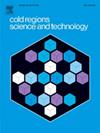A probabilistic methodology to estimate site-scale thaw settlement in permafrost terrain under climate change
IF 3.8
2区 工程技术
Q1 ENGINEERING, CIVIL
引用次数: 0
Abstract
In permafrost terrain climate change poses a severe threat to infrastructure. Deterministic methods for predicting soil temperature profiles struggle to account for inherent uncertainties in soil properties and surface conditions such as spatial and temporal variations and heterogeneity in surface material characteristics. This paper addresses this limitation by developing a probabilistic thermal analysis model using Monte Carlo simulations in Python, integrated with TEMP/W software. The model provides an estimate of site-scale thaw depth and associated thaw settlement of permafrost sediments in Hudson Bay Railway region under the worst-case climate scenario predictions for 2023–2100. The results of this study indicate that understanding the initial ground temperature conditions is critical for realistic predictions of both short-term and long-term thaw depths and thaw settlement variability. This research reveals that climate warming trends will likely accelerate the rate and depth of permafrost thaw, as evidenced by the increasing variability of possible thaw depth and settlements, which become more diverse and exhibit multiple probabilities as climate warming intensifies throughout the century. The methodology was also used to understand the sensitivity of input parameters and identified moisture content and thawing and freezing indices as the key drivers influencing the magnitude and variability of estimated thaw settlement, respectively. The methodology presented in this study provides valuable information on the distribution of potential outcomes when climate change is incorporated into thaw prediction. This research builds on existing knowledge of uncertainties in permafrost modeling with climate change scenarios and contributes by providing a probabilistic framework that integrates these uncertainties into infrastructure resilience, serviceability, and maintenance assessments.
气候变化下冻土地址尺度融化沉降估算的概率方法
在永久冻土区,气候变化对基础设施构成严重威胁。预测土壤温度剖面的确定性方法难以解释土壤性质和表面条件的固有不确定性,例如空间和时间变化以及表面材料特征的异质性。本文通过在Python中使用蒙特卡罗模拟开发一个概率热分析模型来解决这一限制,并集成了TEMP/W软件。该模型提供了在2023-2100年最坏气候情景预测下哈德逊湾铁路地区永久冻土融化深度和相关融化沉降的站点尺度估计。研究结果表明,了解初始地温条件对于短期和长期融化深度和融化沉降变化的现实预测至关重要。这项研究表明,气候变暖趋势可能会加速永久冻土融化的速度和深度,这一点可以从可能的融化深度和沉降的变异性增加中得到证明,随着整个世纪气候变暖的加剧,这些变异性变得更加多样化,并表现出多种可能性。该方法还用于了解输入参数的敏感性,并确定水分含量和融化和冻结指数分别是影响估计融化沉降幅度和变异的关键驱动因素。本研究中提出的方法提供了有关将气候变化纳入融雪预测时潜在结果分布的宝贵信息。本研究建立在气候变化情景下永久冻土建模不确定性的现有知识基础上,并提供了一个概率框架,将这些不确定性整合到基础设施的复原力、可维护性和维护评估中。
本文章由计算机程序翻译,如有差异,请以英文原文为准。
求助全文
约1分钟内获得全文
求助全文
来源期刊

Cold Regions Science and Technology
工程技术-地球科学综合
CiteScore
7.40
自引率
12.20%
发文量
209
审稿时长
4.9 months
期刊介绍:
Cold Regions Science and Technology is an international journal dealing with the science and technical problems of cold environments in both the polar regions and more temperate locations. It includes fundamental aspects of cryospheric sciences which have applications for cold regions problems as well as engineering topics which relate to the cryosphere.
Emphasis is given to applied science with broad coverage of the physical and mechanical aspects of ice (including glaciers and sea ice), snow and snow avalanches, ice-water systems, ice-bonded soils and permafrost.
Relevant aspects of Earth science, materials science, offshore and river ice engineering are also of primary interest. These include icing of ships and structures as well as trafficability in cold environments. Technological advances for cold regions in research, development, and engineering practice are relevant to the journal. Theoretical papers must include a detailed discussion of the potential application of the theory to address cold regions problems. The journal serves a wide range of specialists, providing a medium for interdisciplinary communication and a convenient source of reference.
 求助内容:
求助内容: 应助结果提醒方式:
应助结果提醒方式:


